 WEATHER
WEATHERThe climatic behavior during the 2011-2012 wheat campaign is described once again resorting to the use of a method to calculate the water reserves in the soil and its anomalies. These, which we call “Soil Moisture Classification”, were calculated as a monthly average during the whole wheat cycle, although they come from a daily analysis and express the degree of separation from the habitual conditions for each region and period of the year. Moisture classification is an adequate climatic indicator because it summarizes the behavior of the most relevant climatic variables, such as spatial and temporal distribution of rainfalls and its interaction with the evapotranspiration which in turn depends on the environmental temperature, solar radiation, wind and atmospheric humidity.
The climatic behavior during the 2009-2010 wheat campaign is described once again resorting to the use of a method to calculate the water reserves in the soil and its anomalies. These, which we call “Soil Moisture Classification”, were calculated as a monthly average during the whole wheat cycle, although they come from a daily analysis and express the degree of separation from the habitual conditions for each region and period of the year. Moisture classification is an adequate climatic indicator because it summarizes the behavior of the most relevant climatic variables, such as spatial and temporal distribution of rainfalls and its interaction with the evapotranspiration which in turn depends on the environmental temperature, solar radiation, wind and atmospheric humidity.
 MAY 2011
MAY 2011
The beginning of the wheat campaign presented very good humidity conditions in the Province of Córdoba, in the center of the Pampeana region and North Center of La Pampa province, however, in the Southeast of Buenos Aires province the conditions were normal or below the climate values, a situation that was extended towards the Northeast of Santa Fe province and West of Córdoba.p>
 JUNE 2011
JUNE 2011
It was maintained and increased soil humidity conditions below normal in a large part of the Southeast of Buenos Aires, in the South of Córdoba and in the Province of San Luis, and that situation led to the lack of surface humidity for the sowing. The conditions of soil humidity continued to be very good in a large part of the rest of the wheat region, allowing a normal calendar of sowing.p>
 JULY 2011
JULY 2011
There was a significant change that benefited the wheat nucleus at the Southeast part of Buenos Aires Province, i. e., the atmospheric conditions provided a water availability that modified the conditions of humidity and permitted the sowing and a very good start to the wheat campaign. The dry conditions were intensified to the South of Buenos Aires Province, South and West of Córdoba and San Luis.p>
 AUGUST 2011
AUGUST 2011
The negative water anomaly continued to intensify in the Center-West Pampeana region with a nucleus at the South of Córdoba and adjoining areas, and curiously there was a situation similar to the one of the previous campaign. In Entre Ríos province there was only a situation under the normal one in the Southern region. Although the negative anomaly was also extended towards the South of Santa Fe, the wheat situation was still acceptable.
 SEPTEMBER 2011
SEPTEMBER 2011
The situation in October was very interesting, in fact, the conditions were good for the development of wheat in almost all the Province of Santa Fe, La Pampa and nearly all the Province of Entre Ríos except for its Southern region. The conditions were dry or very dry in the Northwest of Buenos Aires Province and and also in its Center/South region, and the soil humidity maintained normal in the wheat nucleus. In Buenos Aires southeast, the humidity was enough to face the period with increasing water demands in that region.p>
 OCTOBER 2011
OCTOBER 2011
The situation in October was very interesting, in fact, the conditions were good for the development of wheat in almost all the Province of Santa Fe, La Pampa and nearly all the Province of Entre Ríos except for its Southern region. The conditions were dry or very dry in the Northwest of Buenos Aires Province and and also in its Center/South region, and the soil humidity maintained normal in the wheat nucleus. In Buenos Aires southeast, the humidity was enough to face the period with increasing water demands in that region.p>
 NOVEMBER 2011
NOVEMBER 2011
Very good conditions in almost all the Pampeana region except for a strip that comprised the Southern part of Santa Fe and Northeast of Buenos Aires province. These conditions allowed a proper continuation of the wheat cycle, and therefore a normal to good harvest was expected, with the possibility of being very good at Buenos Aires southeast, the last one in being harvested and which continued to have excellent water reserves in the soil that reached for the most requiring stages in that area.
 DECEMBER 2011
DECEMBER 2011
Since this was a month of harvest in the Center and North of the region, the negative humidity anomalies in the soil are ussually favorable for the wheat. Only there were positive anomalies in the Southeast of Buenos Aires, the only zone that could have taken advantage of in its last stages of that water benefit.
 JANUARY 2012
JANUARY 2012
A map of the average water situation from this month is added, since it is still a harvest period in the Southeast part of the wheat area. The soil moisture slightly above normal did not influence the harvest tasks.
| MAY 2011 | JUNE 2011 | JULY 2011 |
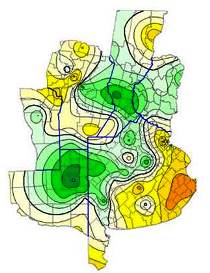
|
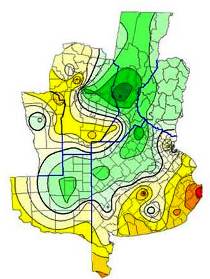
|
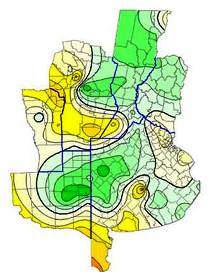
|
| AUGUST 2011 | SEPTEMBER 2011 | OCTOBER 2011 |
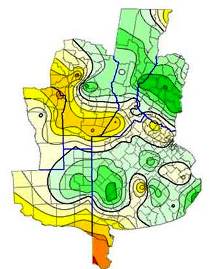
|
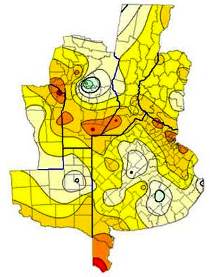
|
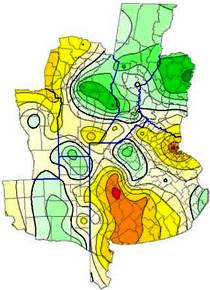
|
| NOVEMBER 2011 | DECEMBER 2011 | JANUARY 2012 |
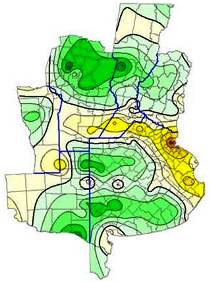
|
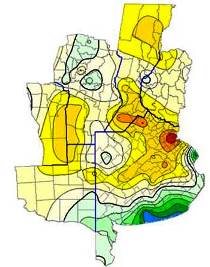
|
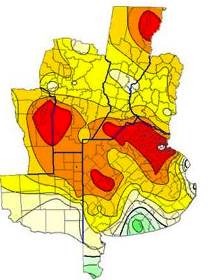
|
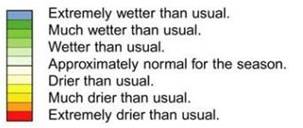
| ||







